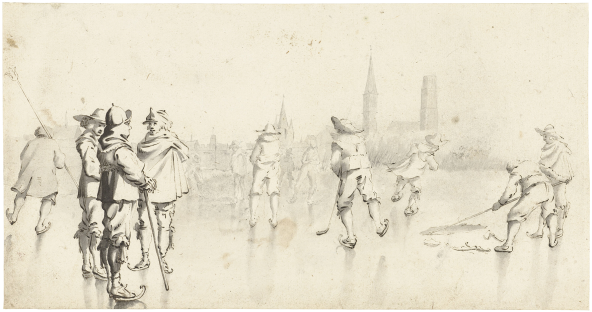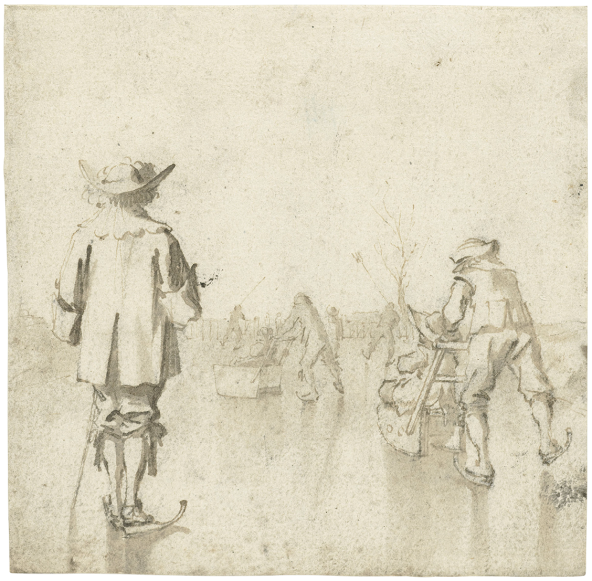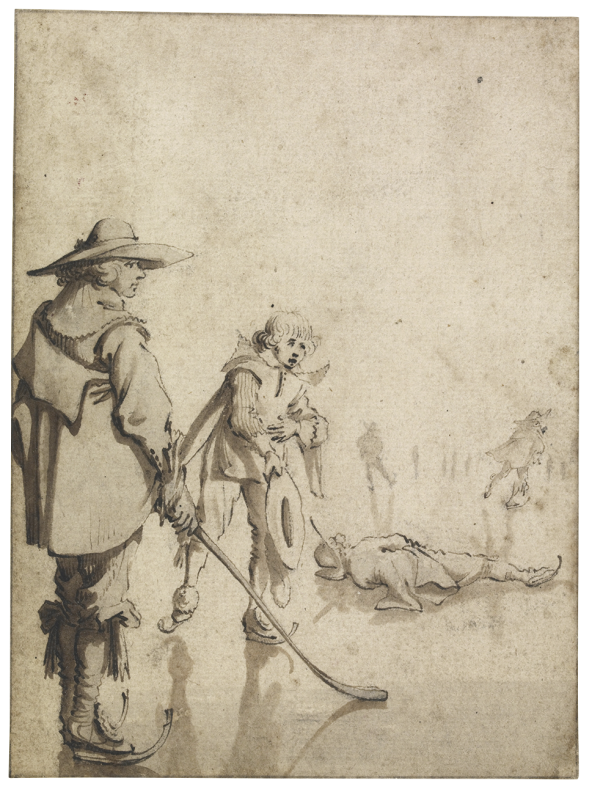Choose a background colour
Gerard ter Borch, Dutch, 1617-1681: Ice Scene with Two Men Pushing a Sled, c. 1633-34
Pen and brown-black ink and brown wash on paper; framing lines in black chalk.
3 11⁄16 × 2 11⁄16 in. (9.3 × 6.8 cm)
Verso, lower left in brown ink (in the hand of Goll van Franckenstein), N3698 (the final digit corrected from a 9); and upper left, in pencil, M26.
- Chain Lines:
- Vertical, 20mm.
- Watermark:
- None.
- Provenance:
Johann Goll van Franckenstein, 1722 – 1785, Amsterdam (Lugt 2987, handwritten inventory number on verso); by descent to his son, Johan Goll van Franckenstein, 1750 – 1821, Amsterdam; possibly Charles Duits, 1882– 1969, London (Lugt 533a); sale, Sotheby’s, Amsterdam, 10 November 1998, lot 44; Sheldon and Leena Peck, Boston (Lugt 3847); gift to the Ackland Art Museum, inv. no. 2017.1.9.
- Literature/Exhibitions:
None.
- Ackland Catalogue:
- 2017.1.9
During the seventeenth century in the Netherlands, frigid temperatures often endured for months, freezing canals, rivers, and waterways that were, pragmatically, used by the Dutch people for both transportation and recreation. Artists were especially inspired by their icy surroundings, among them Gerard ter Borch, who completed several drawings of wintertime activities around the age of sixteen. Here, two men push a woman in a sled without the aid of skates past cursorily drawn buildings that perhaps represent the city of Zwolle.
Ter Borch’s skillfully rendered drawing once belonged to a larger sheet, a recently identified work in the British Museum, London, which depicts additional figures playing kolf, an early form of golf played on ice.
This previously unpublished drawing offers a charming and infrequent addition to the drawn oeuvre of Gerard ter Borch II, one of the leading genre painters of his generation whose innovations would have a lasting impact on a number of other major artists, including Johannes Vermeer.1
His surviving drawings number about 175 sheets.2
The vast majority of these, all but about two dozen, remained part of the family estate for nearly two centuries, descending through the generations without much outside notice until it reached the attention of Abraham Bredius in 1882.3
The family’s collection (which also contains drawings by Ter Borch’s talented siblings, such as his brother Moses and his prolific sister Gesina) reached auction shortly thereafter, with almost all of it reaching the Rijksmuseum. Alison McNeil Kettering published a thorough catalogue of this exceptional and perhaps unique example of a nearly fully preserved assemblage of drawings from a seventeenth-century artists’ family to reach the present.4
As Kettering observes, we can logically assume that most of Ter Borch’s few drawings outside of this group, such as the present sheet, were most likely gifted or sold by the artist during his lifetime.5
Further evidence for this notion can be found in the slightly greater degree of finish one sometimes encounters these works, which Ter Borch may have worked up further in the studio before releasing them. The washes he added to this particular work are highly effective in accentuating the clothing of the men pushing the sled, for example, and his subtle control of the brush also crafts a remarkably nuanced sense of the ice, with its flat glossy surface and muted reflections. Amazingly, Ter Borch was only about sixteen years old when he made this drawing. We know this because it accords very well with a group of ice-scenes he drew in the winter of 1633-34, some of which his father inscribed with Gerard’s name and the exact date of creation, ranging from November 24, 1633 to January 25, 1634.6
His father began this practice of inscribing his drawings when Gerard was eight years old, no doubt proud of his artistically-gifted son and desiring to document his efforts. Despite the artistic inclinations of many members of the family, Gerard would become the only one to fulfill a career as a professional painter.7
After a short period of training under Pieter de Molijn in Haarlem, Ter Borch entered the guild there in 1635, which at eighteen years old was a remarkably young age to become a master.
These ice-scenes were therefore made around the time of his apprenticeship. Haarlem artists such as Jan and Esaias van de Velde already had developed a rich artistic tradition of depicting local ice-scenes, observed especially in their prints. Another source of inspiration was probably the work of Hendrick Avercamp, who painted and drew a large number of winter scenes in Kampen, near Ter Borch’s hometown of Zwolle.8
This present sheet was most likely made in Zwolle, given that some of the city’s towers and spires feature in another drawing from the 1633-34 group showing skaters in front of the city walls Fig. 1.9
The figure on the left with the staff in this drawing even wears headgear with a visor and draped neck covering such as the one worn by the righthand figure in the Ackland’s sheet. It appears that Ter Borch wintered with his family in Zwolle between periods of formal training in Haarlem (and perhaps Amsterdam), but kept his pen and brush active while he was home. Another drawing from this group, somewhat looser but comparable in style, shows men likewise pushing sleds with occupants Fig. 2.10
Unlike the figures in the latter sheet, the men in the Peck drawing apparently have no need of skates (though they perhaps have some sort of ice-grabbing attachment on their shoes). In all the drawings from this group, Ter Borch manages to create a vivid sensation of the misty chill on the ice, in which figures rapidly fade into shadowy forms as they recede from the viewer. They also reveal Ter Borch’s proclivity for depicting figures from behind, which Gudlaugsson noted as a leitmotif in his early works generally.11
The cropped nature of the composition reflects its trimming at some point, most evident along the left edge. It was likely cut away from a larger sheet containing another part of the scene. A good candidate for the missing portion is a drawing now in the British Museum that is also one of the few to have survived outside of the family’s collection now in the Rijksmuseum Fig. 3.12
This drawing is about twice as large as the Ackland’s, but when the images are placed at relative scale with their bottom edges aligned, the horizon line and distant skaters match exactly, as does the perspectival angle of the ice and the relative scale of the foreground figures. How much of the composition is missing between the two extant parts is difficult to say, but it does appear that the figure doffing his hat with his hand over his chest in the London sheet is addressing the lady (and perhaps an additional occupant?) in the sled coming towards him.13
Meanwhile the well-dressed man playing kolf, an early form of golf played on ice, has stopped to take notice as well.14
The figure who has slipped and fallen – a common trope in Dutch ice-scenes – might, however, provide an obstacle for the sled drivers depending on their now difficult-to-judge angle of approach. Significantly, the artist’s name (G Terbourg) and date (25 January 1634) appear on the verso of the British Museum drawing, though these were clearly added by a later owner who used spellings inconsistent with seventeenth-century usage. The inscription nevertheless probably repeats one that must have originally been recorded on the sheet (probably again by Ter Borch’s father) before being trimmed away, thereby felicitously preserving the exact date of the present drawing as well. One of the charms of this sheet is that it is the only one of his ice-scenes to provide a glimpse of a lady, seemingly prefiguring one of those unobtainable Petrarchan beauties that would later feature in so many of his genre paintings.15

Gerard ter Borch II, Skaters Outside the Zwolle City Walls, 1633-34. Pen and brush in black and brown ink on paper, 151 x 290 mm. Amsterdam, Rijksmuseum, inv. no. RP-T-1887-A-832.
Rijksmuseum, Amsterdam

Gerard ter Borch II, Man Watching Skaters, 1633-34. Pen and brown ink and wash over traces of black chalk on paper, 117 x 120 mm. Amsterdam, Rijksmuseum, inv. no. RP-T-1887-A-831.
Rijksmuseum, Amsterdam

Gerard ter Borch II, Ice Scene with Kolf Players, 1634. Pen and brush in brown ink, 139 x 103 mm. London, British Museum, inv. no. 1989,0513.82.
© The Trustees of the British Museum
End Notes
For the basic literature on Ter Borch, see Gudlaugsson 1959-60; The Hague 1974; Kettering 1988; Washington & Detroit 2004-05. For his influence on Vermeer and other genre painters, see Paris, Dublin & Washington 2017-18, passim.
The drawings are catalogued in full in Kettering 1988, vol. 1, 85-191 (for those in the Rijksmuseum), and vol. 2, Appendix 1, 814-840. Only a few drawings have come to light in the interim, including the present sheet; as well as one notable re-attribution to Ter Borch, for which see Rubinstein 2015.
For this story, see the Foreword by J.W. Niemeijer in Kettering 1988, vii-ix.
Kettering 1988, vol. 1, 88.
For this group of ice-scenes, see Kettering 1988, vol. 1, 88. For dated sheets, see Kettering 1988, vol. 2, 824-825, Appendix 1, no. 19 (dated November 24, 1633); vol. 1, 110-111, no. GJr 33 (dated January 23, 1634); and vol. 2, 828-829, Appendix 1, no. 27 (dated January 25, 1634).
For Ter Borch’s early years, see A.K. Wheelock in Washington & Detroit 2004-05, 4-7; and Kettering 1988, vol. 1, 86.
For winter scenes in Dutch art generally, see, among others, The Hague 2001-02; and Stechow 1966, 82-100.
Kettering 1988, vol. 1, 112-113, no. GJr 35; The Hague 1974, 218, no. 83. One can observe in the background, from left to right, the Broerkerk, Janbaghstoren, Grote Kerk, and Onze Lieve Vrouwe Kerk.
Kettering 1988, vol. 1, 112-113, no. GJr 34.
Gudlaugsson 1959 – 60, vol. 1, 14.
Kettering 1988, vol. 2, 828-829, Appendix 1, no. 27; De Rothschild 1987, no. 40.
Kettering’s idea (idem, no. 27) is that the man doffing his hat is playing a game of ‘tip-cat’ (tiepelen) such as found in a couple of drawings by Harmen Ter Borch (for which see Kettering 1988, vol. 1, nos. H 62 and H 75), but the figure in the British Museum sheet is most likely bowed in greeting with the appropriate hand gesture, which is only now more apparent when placed next to the Ackland’s drawing.
For the game of kolf, see Van Hengel 1985, 36. Ice provided the long stretches of smooth surface desirable for the game.
See Kettering 1993 for these famous ‘Ladies in Satin’.
